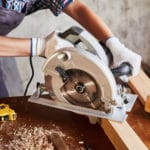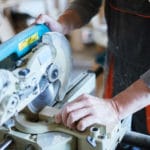A jigsaw is a saw that cuts with a toothed blade. It can be used for cutting curves or straight lines, depending on the type of blade it uses. The blades are available in different shapes and sizes but they are all cut by means of teeth at the edge which is brought into contact with the material being cut.
If you are interested in learning more about this tool, keep reading below. We’ll go over some of the benefits of using a jigsaw as well as some safety tips that should be followed while operating one.
Pick the Right Blade
Using the wrong blade could lead to injury and damage to your material. Using a coarse tooth blade will provide you with quick cuts but it is more likely that the wood will splinter, which means an inferior cut. A finer-toothed blade will produce cleaner cuts but they take longer than those made by coarser blades.
Use Rough Sandpaper
To remove the splinters that are created when cutting, you will need to use rough sandpaper to clean up your cut pieces. If there is still a little bit of material left after the cuts have been made, this step can be skipped but it should always be done if you plan on painting or staining your project.
Use Oscillating Blade
The higher-end jigsaws often have a feature called the “oscillating” blade which moves back and forth as well up or down. This is because it provides more power without increasing the risk of edge burrs or splintering, making for faster cutting speeds with less work required.
Be Careful While Using a Jigsaw
Even if the saw is lightweight, you should always wear gloves when cutting with it to prevent injuries such as cuts and scrapes on your hands. You should also be careful about where the cord of the tool is located. Never allow it to get caught up in work or become a tripping hazard for yourself or others.
Preparing the Jigsaw
Put the blade into place and then make sure your saw is unplugged. Some have a bolt that must be loosened with an Allen wrench before changing blades, while others feature a lever that can come down when pulled in order to insert new ones safely.
Make sure you are facing towards where these teeth would go (front of jigsaw), grip firmly so as not to drop it during operation on top of itself but also take care not to get hit by any loose debris from construction sites or else injury may result.
Cutting the Material
When cutting with a jigsaw, make sure that the foot of your tool is pressed flat against whatever material you’re working on. Ensure there’s no blade touching any part before pulling back. Just let it go as soon as it starts moving forward at full speed and cut into your project.
If pushing too hard causes the blade to recoil frequently, then stop immediately because using force may break off pieces or damage the surface finish.
Don’t Rush the Job
Rushing a jigsaw cut can lead to a piece being torn off or even injury due to the blade sticking in the material at an angle and snapping back into your hand or arm, which can potentially cause you harm. Instead of rushing through it, take time with each cut so that everything is executed properly.
Precautions When Cutting Tile
Tile cutting is a delicate matter that requires patience and steady hands. A tile saw must be used for this task, but if you want to learn how using jigsaw on tiles work instead of buying another new power tool there are some things that will help out in your quest.
First, put masking tape down either near where it’s being cut or along the bottom edge so as not to scratch the surface.
Second, use the corresponding blade with the appropriate size. You want higher quality blades than most DIY brands since they’re designed specifically towards cutting through tough surfaces such as tiles. Third, remember when going slowly let the machine do all hard work by keeping fingers away until the job is done.
Safety Tips for Operating a Jigsaw
It is important to keep in mind the safety precautions when working with a jigsaw. Make sure you are safe and check your surroundings before starting any project or job that involves this tool, as it can be quite hazardous if used incorrectly.
- Wear safety glasses to protect your eyes from dust and debris.
- Be aware of where the cord is located at all times in case you trip over it.
- Keep the blade at a 90 degree angle to the material when cutting straight. When cutting curves, do not apply too much pressure to the handle. Instead, tilt your jigsaw slightly forward so that only one side of the blade touches the material.
- Make sure that your saw is firmly mounted to a stable surface, and use your wrist to hold it steady while you make each cut rather than putting stress on your whole arm.
- Don’t try to force a jigsaw if it seems like it’s not cutting properly; this could cause injury or damage to your material.
- If the blade binds up while you are cutting, don’t try to remove it yourself. Turn off your jigsaw before dealing with the problem.
- Be aware of where nearby objects are located in case they get hit by debris or dust thrown up during use.
- Don’t cut towards yourself if possible – make your cut from the opposite side and let the blade come up to you.
- Never use a jigsaw that has been dropped or suffered other damage. It could be dangerous to try using such a tool, even if only minor repairs are needed. Look for obvious fractures in material like plastic casings before trying to turn on any power tools after they’ve been dropped.
Cleaning Up Your Jigsaw
Once you are done cutting, make sure to sand all of the edges of your material with an orbital sander or belt sander. Depending on what size and type of tool are being used, this can be done in different ways.
For smaller projects like plastic or wood, it might just take some time behind a belt-driven device. Anything bigger requires more powerful tools such as drills and grinders instead.
Once everything has been smoothed out properly we recommend vacuuming up any sawdust that may have accumulated (especially near where dust collection points exist) so nothing gets dirty again during future work sessions. Finally, store away both blade and jigsaw when finished use because accidents happen.




